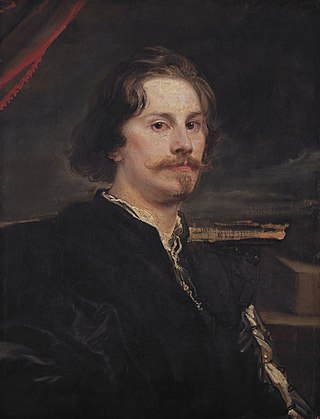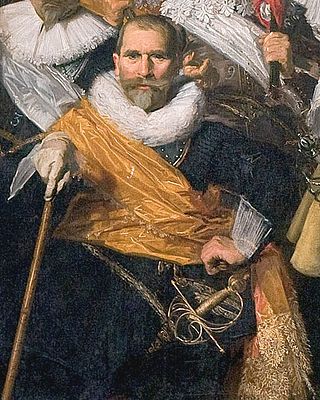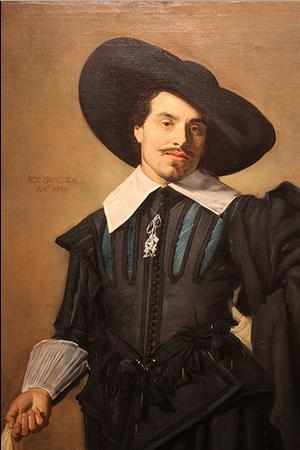
Hendrik Gerritsz Pot was a Dutch Golden Age painter, who lived and painted in Haarlem, where he was an officer of the militia, or schutterij. Dutch artist Frans Hals painted Pot in militia sash in Hals' The Officers of the St Adrian Militia Company in 1633. Pot is the man reading a book on the far right.

Schutterij refers to a voluntary city guard or citizen militia in the medieval and early modern Netherlands, intended to protect the town or city from attack and act in case of revolt or fire. Their training grounds were often on open spaces within the city, near the city walls, but, when the weather did not allow, inside a church. They are mostly grouped according to their district and to the weapon that they used: bow, crossbow or gun. Together, its members are called a Schuttersgilde, which could be roughly translated as a "shooter's guild". It is now a title applied to ceremonial shooting clubs and to the country's Olympic rifle team.

The Stadsbibliotheek Haarlem is a collective name for all public libraries in the Haarlem area of the Netherlands. The first public library of Haarlem opened in 1921 at the cloisters of the Haarlem City Hall where the academic library had been since 1821. The move to open its doors to the public with a public reading room was only possible after the previous occupant of the downstairs cloisters, the Frans Hals Museum, moved out in 1913 to its present location. As of 2009, there are 6 public libraries and 10 lending points, such as in hospitals.

Pieter Claesz Soutman was a Dutch Golden Age painter and printmaker from Haarlem.

The Banquet of the Officers of the St George Militia Company in 1616 refers to the first of several large schutterstukken painted by the Dutch painter Frans Hals for the St. George civic guard of Haarlem, and today is considered one of the main attractions of the Frans Hals Museum, Haarlem.

Pieter Jacobsz Olycan, was a Dutch brewer, magistrate, and later mayor of Haarlem, best known today for his portraits by Frans Hals, as well as for the portraits of his wife Maritge Claesdr. Voogt.

Banquet of the officers of the Calivermen Civic Guard, Haarlem formerly known as The Banquet of the Officers of the St Adrian Militia Company in 1627, refers to a schutterstuk painted by Frans Hals, in 1627, for the St. Adrian civic guard of Haarlem. Today it is considered one of the main attractions of the Frans Hals Museum, in Haarlem.

The Officers of the St Adrian Militia Company in 1630 refers to the schutterstuk painted by Hendrik Gerritsz Pot for the Cluveniers, St. Adrian, or St. Hadrian civic guard of Haarlem, and today is considered one of the main attractions of the Frans Hals Museum there.

Nicolaes Woutersz van der Meer was a Dutch brewer, magistrate and mayor of Haarlem, best known today for his portrait with its pendant of his wife Cornelia Claesdr Voogt, both painted by Frans Hals in 1631.

The Banquet of the Officers of the St George Militia Company is an oil-on-canvas painting by the Dutch artist Frans Hals, painted from 1626 - 1627, during the Dutch Golden Age. Today, the piece is considered one of the main attractions of the Frans Hals Museum.

The Officers of the St George Militia Company in 1639 refers to the last and largest schuttersstuk painted by Frans Hals for the St. George civic guard of Haarlem, and today is considered one of the main attractions of the Frans Hals Museum in Haarlem.

Michiel de Wael, was a Dutch brewer and citizen of Haarlem, best known today for his portraits painted by Frans Hals. His grandfather, also a brewer, was one of the first Calvinists in the city and was involved in the Siege of Haarlem.

Johan Claesz van Loo, was a Dutch brewer, owning De Drie Leliën in Haarlem, best known today for his portrait painted by Frans Hals.

The Meagre Company, or The Company of Captain Reinier Reael and Lieutenant Cornelis Michielsz Blaeuw, refers to the only militia group portrait, or schutterstuk, painted by Frans Hals outside of Haarlem. Today the painting is in the collection of the Amsterdam Museum, on loan to the Rijksmuseum, where it is considered one of its main attractions of the Honor Gallery. Hals was unhappy about commuting to Amsterdam to work on the painting and, unlike his previous group portraits, was unable to deliver it on time. The sitters contracted Pieter Codde to finish the work.

The Haarlem schutterij refers to a collective name for the voluntary civic guard of Haarlem, from medieval times up to the Batavian Revolution in 1794, when the guilds of Haarlem were disbanded.

Willem Claesz Vooght (1572–1630), was a mayor of Haarlem best known today for the portrait painted of him by the painter Frans Hals.

Cornelis Coning or Koning, was an engraver and mayor of Haarlem.

Florens Pietersz van der Houff, was a magistrate and mayor of Haarlem who became a member of the Admiralty of Amsterdam during the years 1655 - 1657.

Lucas van Tetrode, or Tetterode, was a Dutch Golden Age member of the Haarlem schutterij.

Pieter de Jong, was a Dutch Golden Age member of the Haarlem schutterij.























